
Living Walls
by Kelly Hart
We have all heard about green roofs and know about their environmental advantages, but there is a new concept that is taking root, especially in urban environments: green walls or living walls. Better than the old ivy-covered buildings, which can be adversely affected by the vines, these walls are designed to feature a variety of different plants in a vertical environment, and provide all of their needs for moisture and support right on the wall.
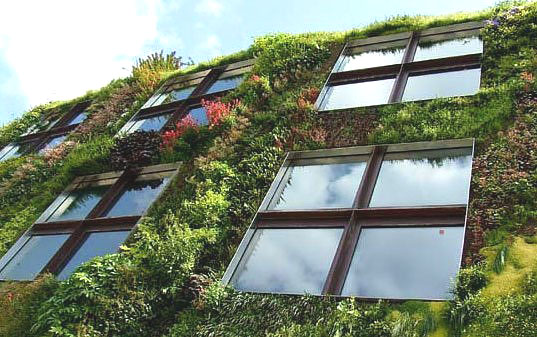
These walls can be either exterior of interior, and they provide advantages in both situations. On the outside they will shade the wall from the intensity of the sun, and thus moderate the temperature considerably, as well as provide lovely textural contrast and beauty. Plant surfaces, as a result of transpiration, do not rise more than 4-5 °C above the ambient and are sometimes even cooler. On the inside they will filter and oxygenate the air, providing a healthier indoor environment, while also creating the calming effect that natural plants tends to have on most people.
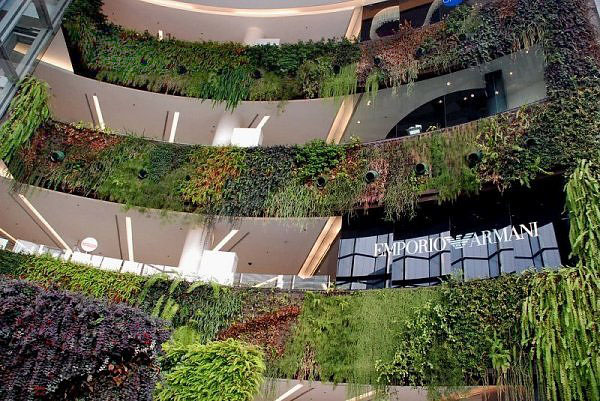
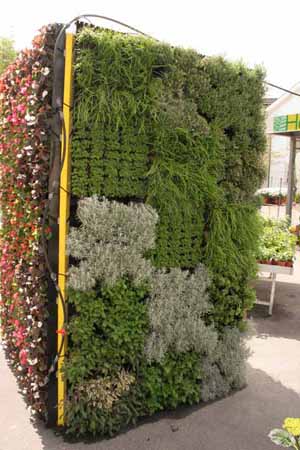 Vertical gardens can be grown on just about any type of wall, with or without the use of soil. Many living wall kits come with modular forms that are assembled and applied to a frame that then is affixed to the wall. The most common frame for sale today is a panel that is self-supporting and can be set up independently or attached to a real wall. It is then filled with soil or a soil-less medium and planted. Once the initial panels are in place living walls require little maintenance. They are designed so that their upkeep is about the same as a landscaped garden.
Vertical gardens can be grown on just about any type of wall, with or without the use of soil. Many living wall kits come with modular forms that are assembled and applied to a frame that then is affixed to the wall. The most common frame for sale today is a panel that is self-supporting and can be set up independently or attached to a real wall. It is then filled with soil or a soil-less medium and planted. Once the initial panels are in place living walls require little maintenance. They are designed so that their upkeep is about the same as a landscaped garden.
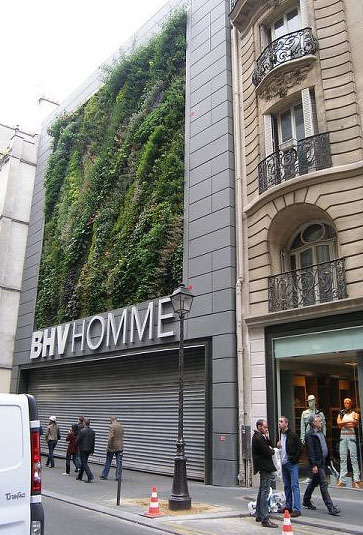
In felt systems plants are fitted into felt pockets of growing medium and then attached to a waterproofed backing which is then connected to the building behind. An example of a felt system is Patrick Blanc's Vertical Garden which is composed of a metal frame, a thin PVC sheet, and a felt polyamode layer which is attached to the PVC. Water and nutrients are fed to the wall through some means of mechanical irrigation. Some living wall systems are designed to collect rain water and/or reuse gray water.
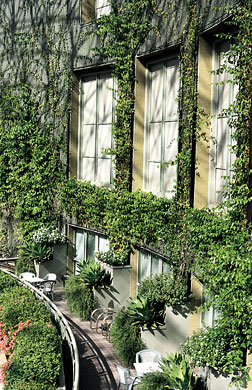
A container or trellis system consists of plants that are grown in containers which climb onto trellises. Irrigation drip lines are put in place to control the watering and feeding of the plants. Some long vines will grow and root their way up the wall as they climb. Main roots are embedded in the ground and the medium of the wall need only be kept moist to support the climbing roots.
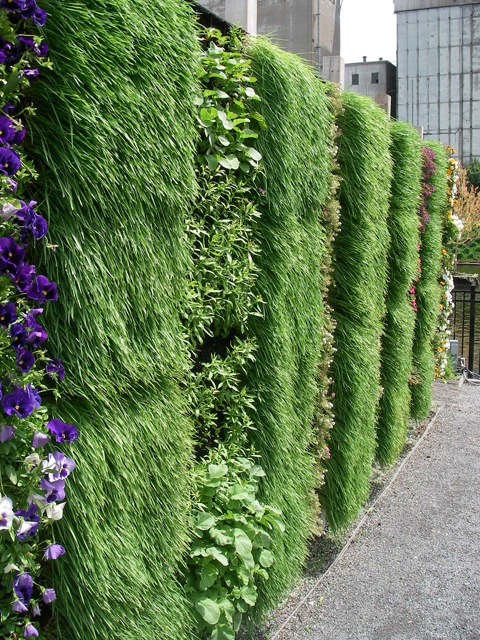
The panels are designed to allow the water to flow from cell to cell within the panel and from panel to panel within the wall. The water flows internally within the panels. The water flows from the top grooves in each panel, through the subsequent grooves, until it reaches to bottom of the panel where it drips out from the drainage channels and into the panel below. Irrigation systems are designed with automatic timers for ease of use.
These systems allow the plants to grow and spread while preventing or minimizing damage to the structure. When grown up the wall of a building or other structure, it is important that there should be an efficient waterproof lining between the planting area and the supporting structure to keep water from seeping into walls. Also, you need to have a very solidly-built wall to work on, or you might need to reinforce the wall so it can take the extra weight.
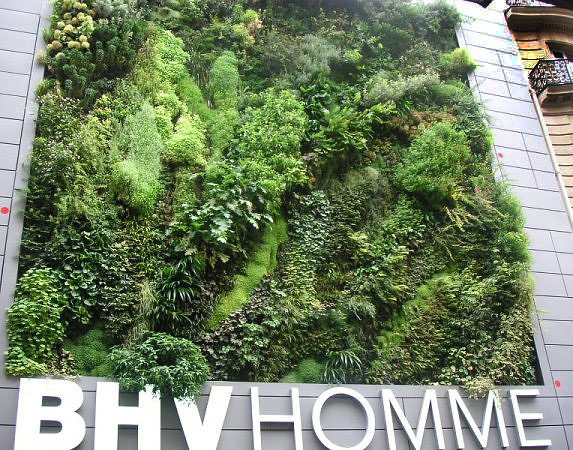
The plants used for a living wall vary depending on the amount of sunlight available, the space available, the location on the wall, different exposure to water, and whether your living wall is indoors or outdoors. There are also many vegetables that have been grown successfully in living walls. Avoid large plants that will put a lot of pressure on the angled root area when growing a pocket system vertical garden. Lightweight leaved plants, plants that cascade and plants that grow in mounds close to the root area are the best selections. Succulents, for example, make fine choices as most will hug the wall, are drought tolerant and form decorative and varied foliage that offer interesting shapes, textures and colors in both leaf and flower.
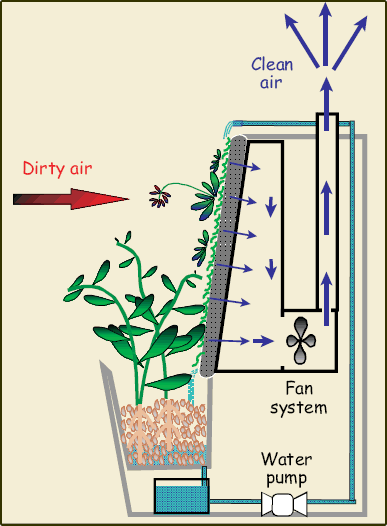
Some "active" living walls are integrated into a building's air circulation system so that the air is actually passed through the root system where most of the pollutants are filtered out. Living walls may also be a means for water reuse. The plants may purify slightly polluted water (such as greywater ) by absorbing the dissolved nutrients. Bacteria mineralize the organic components to make them available to the plants.
The Naturaire Indoor Air Biofilter or "living walls" is an interior plantscape that can effectively remove common indoor contaminants and improve the living environment. It represents the hybridization of science and art to deal with real problems of indoor air quality in an aesthetic and sustainable manner. At first glance, the living wall appears as a vertical hydroponic green wall containing a wide range of foliage and flowering plants specifically selected for each site.
 Living walls have become an art form, and one of the pioneering vertical garden artists is Patrick Blanc. He observed how plants were able to grow vertically without the need for soil in the wild, and soon developed a way to create artistic vegetation walls that were both lightweight and needed little maintenance. Since these living walls only weigh approximately 30 kg or less per square-meter, he noticed that just about any type of wall would be able to support the weight of a vertical garden. At the right is
Patrick Blanc at work, climbing a cliff in Venezuela.
Living walls have become an art form, and one of the pioneering vertical garden artists is Patrick Blanc. He observed how plants were able to grow vertically without the need for soil in the wild, and soon developed a way to create artistic vegetation walls that were both lightweight and needed little maintenance. Since these living walls only weigh approximately 30 kg or less per square-meter, he noticed that just about any type of wall would be able to support the weight of a vertical garden. At the right is
Patrick Blanc at work, climbing a cliff in Venezuela.
Twelve years ago Patrick began designing eco conscious architecture for public spaces, department stores or private living rooms. He worked for museums in Paris, Istanbul, Madrid, Seoul, and elsewhere.
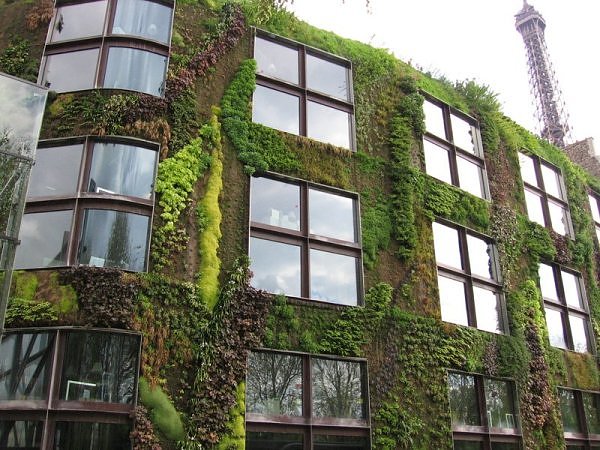
This popular French museum near the Eiffel Tower in Paris is home to one of the best examples of vertical garden work by artist Patrick Blanc. The living wall here is about 200 meters long and 12 meters tall.
In an interview, Patrick Blanc said, "Plants don't need soil because it is merely the mechanical support. Only water and the minerals dissolved in it are essential to plants, together with light and carbon dioxide to conduct photosynthesis. Wherever water is available all year long, as in tropical forests or in temperate mountain forests, plants can grow on rocks, tree trunks, and slopes free of the ground. For instance in Malaysia 2,500 species grow without any soil."
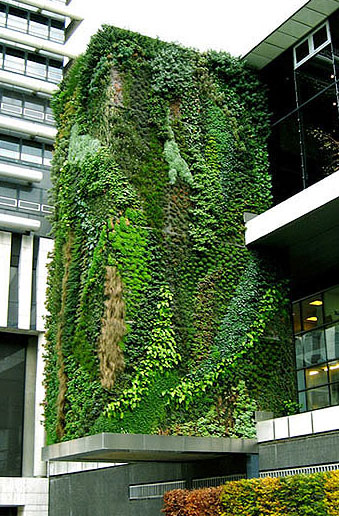 "Water delivery is automated. It's going from the top just as it would in any natural situation on the surface of a cliff or a rock. It's creating its own specific climate. It has been proven that the vertical gardens enhance atmospheric humidity, thus enabling small ferns and mosses to appear and seeds to germinate. When the plant selection is correct, there is no need to change the plants! This is not like an ordinary garden. looking after it three or four times a year is enough. My scientific approach is essential for designing the whole system and for selecting the plant species suitable for each peculiar location."
"Water delivery is automated. It's going from the top just as it would in any natural situation on the surface of a cliff or a rock. It's creating its own specific climate. It has been proven that the vertical gardens enhance atmospheric humidity, thus enabling small ferns and mosses to appear and seeds to germinate. When the plant selection is correct, there is no need to change the plants! This is not like an ordinary garden. looking after it three or four times a year is enough. My scientific approach is essential for designing the whole system and for selecting the plant species suitable for each peculiar location."
Living walls are particularly suitable for cities, as they allow good use of available vertical surface areas. They are also suitable in arid areas, as the circulating water on a vertical wall is less likely to evaporate than in horizontal gardens.
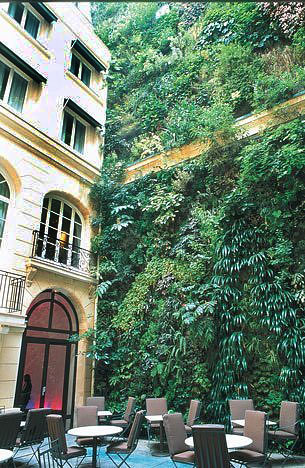
Nestled in the courtyard of the Pershing Hall Hotel (left) is a 30 meter high vertical garden that features over 250 different plant species.
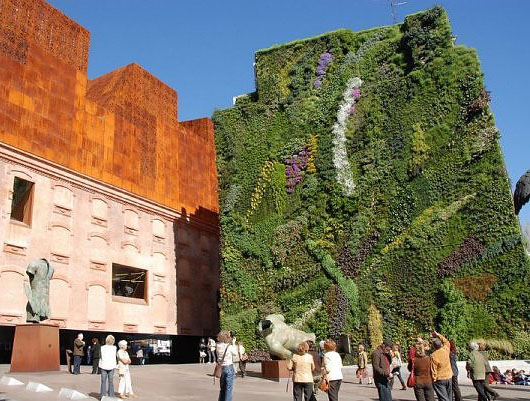
The newest museum in Madrid, designed by Swiss architects Herzog & Meuron, the CaixaForum features an exterior wall with a huge 24 meter high vertical garden with over 15,000 plants from more than 250 different species that are now covering a 1899 converted former power station.
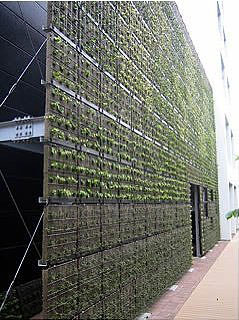 This living wall (left) is manufactured and marketed by two Japanese companies that have created a product that is lightweight, cheap, and very functional. The living wall is called " Parabienta ," and it costs approximately $60 per square foot.
This living wall (left) is manufactured and marketed by two Japanese companies that have created a product that is lightweight, cheap, and very functional. The living wall is called " Parabienta ," and it costs approximately $60 per square foot.
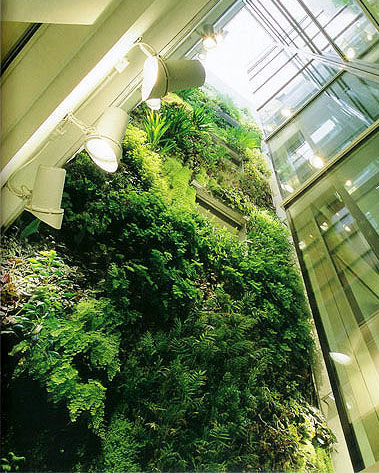
Strategically placing plants vertically alongside an elevator shaft at the Emporium Bangkok can add a nice decorative touch.
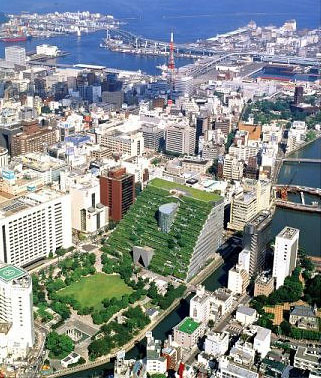
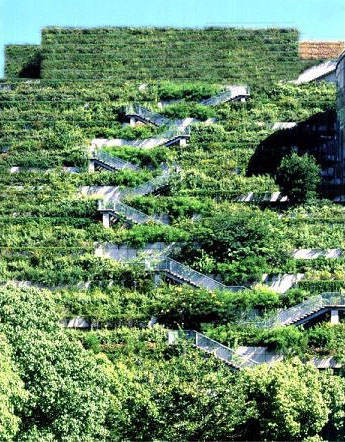
The 100,000 square foot rooftop at the ACROS Fukuoka building features 15 stepped terraces that can actually be climbed to the top. The terraces are meant to promote a serene and peaceful environment in the middle of the city with lots green plants and even waterfalls and small pools to add to the calming effect of the building's extraordinary exterior.
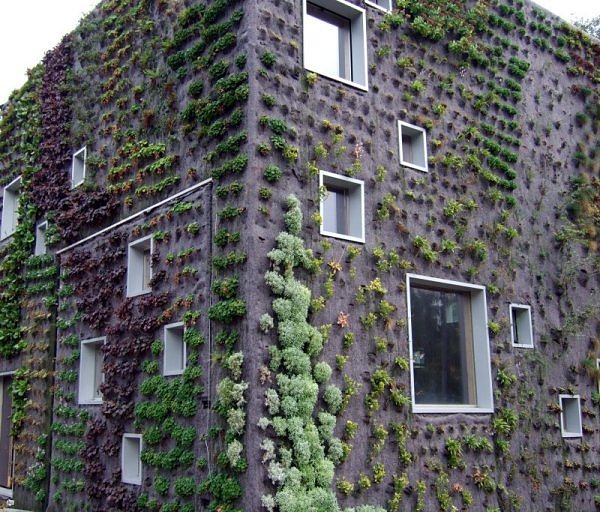
The plants above are growing in a thin layer of felt and rock wool material instead of soil. Recycled rain water is pumped through this material to provide nutrients to the root systems of the plants. It won't be long before the entire facade will be covered.
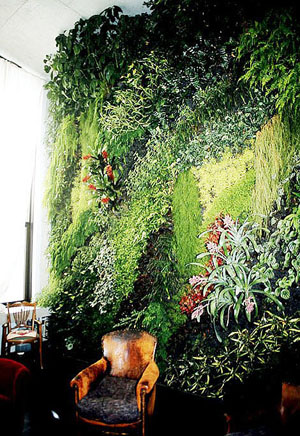
When you combine the obvious environmental benefits of living walls with their sheer beauty I anticipate that we will be seeing many more examples of this wonderful art form.

For Email contact go to About Us
Established in 2001, GreenHomeBuilding.com is primarily a labor of love. Kelly, and the GreenHomeBuilding team of experts, have answered thousands of questions for readers over the years, and we continue to publish up-to-date information about increasingly important sustainable architecture. If you feel moved to assist us in this work, your kind donation would be much appreciated; this can be easily done through our PayPal account:

VISIT OUR OTHER WEBSITES:
[Natural Building Blog] [Earthbag Building] [Dream Green Homes]
Disclaimer Of Liability And Warranty
I specifically disclaim any warranty, either expressed or implied, concerning the information on these pages. Neither I nor any of the advisor/consultants associated with this site will have liability for loss, damage, or injury, resulting from the use of any information found on this, or any other page at this site. Kelly Hart, Hartworks LLC.
